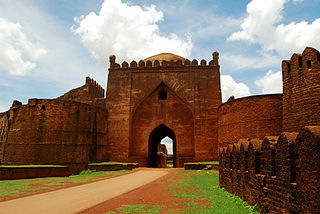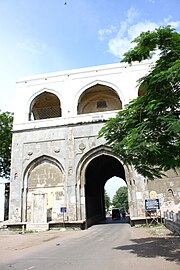
Shaniwar Wada is a historical fortification in the city of Pune, India. Built in 1732, it was the seat of the Peshwas of the Maratha Confederacy until 1818. The fort itself was largely destroyed in 1828 by an unexplained fire, but the surviving structures are now maintained as a tourist site.

Mughal architecture is the type of Indo-Islamic architecture developed by the Mughals in the 16th, 17th and 18th centuries throughout the ever-changing extent of their empire in the Indian subcontinent. It developed from the architectural styles of earlier Muslim dynasties in India and from Iranian and Central Asian architectural traditions, particularly Timurid architecture. It also further incorporated and syncretized influences from wider Indian architecture, especially during the reign of Akbar. Mughal buildings have a uniform pattern of structure and character, including large bulbous domes, slender minarets at the corners, massive halls, large vaulted gateways, and delicate ornamentation; examples of the style can be found in modern-day Afghanistan, Bangladesh, India and Pakistan.

Aurangabad district, officially known as Chhatrapati Sambhajinagar district, is one of the 36 districts of the state of Maharashtra in western India. It borders the districts of Nashik to the west, Jalgaon to the north, Jalna to the east, and Ahmednagar to the south. The city of Aurangabad houses the district's administrative headquarters. The district has an area of 10,100 km2, of which 37.55% is urban and the rest is rural. Aurangabad District is a major tourism region in Marathwada, with attractions including the Ajanta Caves and Ellora Caves.

Indo-Islamic architecture is the architecture of the Indian subcontinent produced by and for Islamic patrons and purposes. Despite an initial Arab presence in Sindh, the development of Indo-Islamic architecture began in earnest with the establishment of Delhi as the capital of the Ghurid dynasty in 1193. Succeeding the Ghurids was the Delhi Sultanate, a series of Central Asian dynasties that consolidated much of North, East, and Central India, and later by the Mughal Empire during the early 16th century. Both of these dynasties introduced Islamic architecture and art styles from West Asia into the Indian subcontinent.

Jaigarh Fort is situated on the promontory called the Cheel ka Teela of the Aravalli range; it overlooks the Amer Fort and the Maota Lake, near Amer in Jaipur, Rajasthan, India.
Jalna is a city in Jalna district in the Aurangabad Division, or Marathwada region, of the Indian state of Maharashtra. It was part of Hyderabad State as a tehsil of Aurangabad district, before Jalna district was formed effective 1 May 1981. Jalna become Maharashtra's 29th Municipal Corporation.

Bhadkal Gate is a structure in Aurangabad City in Maharashtra, India. This gate is the biggest in the city. It was built by Ahamadnagar's Murtaza Nizamshah's vizier Malik Ambar to commemorate the victory against the Mughals in 1612. It is also known as Victory Gate.
Aurangabad is a medieval Indian town named after Mughal Emperor Aurangzeb, who established this town during his tenure as the Viceroy of the Deccan (Dakhin), a geographical region comprising parts of modern-day Maharashtra, Telangana and Karnataka.

The Gates of Delhi were city gates at various medieval townships around Delhi, built under dynastic rulers in the period that could be dated from the 8th century to the 20th century. They are the gates in:

Bidar Fort is located in old city area, Bidar, Karnataka, India. The fort, the city and the district are all affixed with the name Bidar. Sultan Ahmad Shah I of the Bahmanid dynasty shifted his capital from Gulbarga to Bidar in 1427 and built his fort along with a number of Islamic monuments. There are over 30 monuments inside Bidar fort.

When Aurangzeb made Aurangabad his capital, there were 54 suburbs which were walled in like the city itself, but the chief of these that were populated in the 19th century were Begampura and Aurang-pura.

Neher water system provided clean water for the people of Aurangabad and its suburbs. It was created by Malik Ambar who founded the town under the name Khadki and was later expanded by Aurangzeb to facilitate the military activity that became prevalent under Mughal rule during the 17th century.

Salim Ali Lake is located near Delhi Gate, one of the many Gates in Aurangabad, opposite Himayat Bagh, Aurangabad. It is located in the northern part of the city. During the Mughal period, it was known as Khiziri Talab. It has been renamed after the great ornithologist, naturalist Salim Ali and also known as birdman of India. The office of Divisional Commissioner Aurangabad division is located near it, so is the collector's office of Aurangabad District.
Himayat Bagh Biodiversity Heritage site is a 17th-century garden that now houses the Fruit Research Station and Nursery, which is a part of the Vasantrao Naik Marathwada Krishi Vidyapeeth. It is located near Delhi Gate in Rauza Bagh area of Aurangabad, in the Indian state of Maharashtra. It is a sprawling complex spread over 300 acres (1.2 km2), naturally green and in the olden days it was known as the Mughal Garden.
The Jama Masjid is a mosque built in 1612 AD, located near the Killa Arrak in Aurangabad, Maharashtra, India. It is historically significant because it was constructed in 1612 AD, very soon after the foundation of Aurangabad by Malik Amber in 1610 AD. The mosque was later extended by Aurangzeb(R.H) in the year 1692 AD, it is one of the oldest mosques of Aurangabad which is still in good condition.

Bhadra Fort is situated in the walled city area of Ahmedabad, India. It was built by Ahmad Shah I in 1411. With its well carved royal palaces, mosques, gates and open spaces, it was renovated in 2014 by the Amdavad Municipal Corporation (AMC) and the Archaeological Survey of India (ASI) as a cultural centre for the city.

The Darwaja or Gates of Ahmedabad were built during different times starting from 1411 as the entrances to the walled city of Ahmedabad, Gujarat, India.

Qila-e-Ark is a 17th-century palace/citadel complex in Aurangabad, Maharashtra. Built by Mughal emperor Aurangzeb when he was a prince, it served as his royal residence during his subsequent reign as emperor. The site is currently ruined, and has no legal protected status; several modern-day buildings also encroach the complex. Notable surviving structures include a royal mosque, and a palatial building.




























